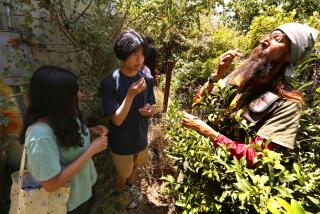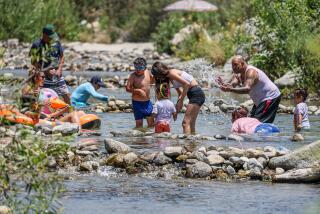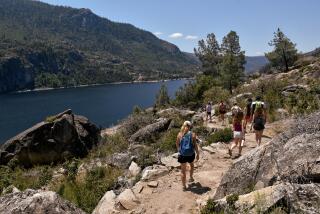RESEDA : Students Take Trash Course in Piru Creek
- Share via
Looking like fleeing refugees, they slogged through the brackish water of the slow-moving stream, dragging behind them plastic bags filled with shoes, food, diapers.
They ducked in and out of the rustling reeds and splashed quickly after one bag of goods that had floated away.
The stream was no war-torn border crossing, however, and the bag was hardly worth rescuing; it was but one of dozens filled Monday by Reseda High School students gathering broken Corona beer bottles, flip-flops and Pampers from the shores and bottom of Piru Creek.
“These people are pigs,” 14-year-old Kenneth Fregozo said of the littering campers.
The trip to the creek north of Castaic marked the first outing for the members of Reseda High’s new Environmental/Physical Sciences Magnet Center. For many of the students, it was their first venture into the Angeles National Forest. And for most, the scene was appalling.
“I’ve been to places that are dirty,” said 13-year-old Natalia Alfaro, “but this beats them all.”
Rotting mattresses, sprawling sheets of plastic, a shattered yellow child’s chair lined the creek near Frenchmans Flat. Soda cans floated in the water and work boots were buried in silt.
The magnet school, established in May, is designed to offer students interested in science a more intense curriculum of study than would typically be found at a public school, preparing them either for college or careers in fields from physics to forestry.
Monday’s field trip was aimed at giving 60 of the 90 magnet school students a taste of the Los Angeles-area wilderness, and of the serious threats to its once-pristine streams.
Muddy shopping carts and floating boxer shorts are not what one hopes to find on an early morning fishing trip, obviously, but the students learned that litter along streams can be more than an eyesore.
Birds can get trapped in the plastic rings used to bind six-packs, said Scott Mathes, executive director of the California Environmental Project, which helped organize the outing. Animals will eat food-stained Styrofoam and can die. Bacteria from human excrement can work their way into the stream, killing fingerling trout and threatening drinking water.
After a morning spent taking Piru Creek’s temperature (68 degrees), measuring its pH level (6), and learning how such figures play into the health of the stream, the students donned green rubber gloves and settled in for the dirty work.
“Hopefully, this will help instill a responsible environmental ethic,” said magnet school coordinator Tony Recalde.
The experience did just that, several students said, promising never again to toss a Big Gulp cup from the car or answer the call of nature within 200 feet of a stream.
But after several hours’ work, far more trash remained on the ground than in the plastic bags. And all of it had accumulated in less than a year, Recalde said, as he and another group of students had cleaned up this same creek six month ago.
Keith Pochmara, 15, shook his head. “I would think people would have more common sense.”
More to Read
Sign up for Essential California
The most important California stories and recommendations in your inbox every morning.
You may occasionally receive promotional content from the Los Angeles Times.










